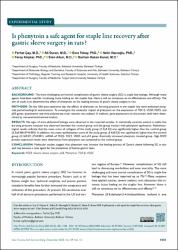| dc.contributor.author | Çay, Ferhat | |
| dc.contributor.author | Duran, Ali | |
| dc.contributor.author | Tokay, Esra | |
| dc.contributor.author | Hacıoğlu, Nelin | |
| dc.contributor.author | Köçkar, Feray | |
| dc.contributor.author | Altun, Eren | |
| dc.contributor.author | Kanat, Burhan Hakan | |
| dc.date.accessioned | 2024-06-05T07:49:03Z | |
| dc.date.available | 2024-06-05T07:49:03Z | |
| dc.date.issued | 2023 | en_US |
| dc.identifier.issn | 1306-696X / 1307-7945 | |
| dc.identifier.uri | https://doi.org/10.14744/tjtes.2023.29035 | |
| dc.identifier.uri | https://hdl.handle.net/20.500.12462/14798 | |
| dc.description | Çay, Ferhat (Balikesir Author) | en_US |
| dc.description.abstract | BACKGROUND: The most challenging and mortal complication of gastric sleeve surgery (SG) is staple line leakage. Although many agents have been used for increasing tissue healing on the stapler line, there is still no consensus on its effectiveness and efficacy. The aim of study is to determine the effect of phenytoin on the healing process of gastric sleeve surgery in rats. METHODS: On the 10th post-operative day, the effects of phenytoin on bursting pressure in the stapler line were evaluated along-side pathohistological examinations. To investigate the molecular impact of phenytoin on the expression of TGF-β, VEGF, FGF2, and p53 genes, quantitative real-time polymerase chain reaction was utilized. In addition, gene expressions at the protein level were determined by immunohistochemical analysis. RESULTS: No signs of intra-abdominal leakage were observed in the resected samples. A statistically essential extend in stable line bursting pressure measure was observed between the control group and the group treated with phenytoin application. Pathohisto-logical results indicate that the mean score of collagens of the study group (3.2±0.42) was significantly higher than the control group (2.3±0.48) (P=0.003). In addition, the mean epithelization score of the study group (3.4±0.52) was significantly higher than the control group (2.1±0.57) (P=0.001). mRNA of TGFβ, FGF2, VEGF, and p53 genes drastically increased phenytoin treated group. High FGF2 protein expression levels were determined from phenytoin use compared to the control group. CONCLUSION: Molecular studies suggest that phenytoin may increase the healing process of Gastric sleeve following SG in rats and may become a new agent for the prevention of human gastric leaks. | en_US |
| dc.description.abstract | AMAÇ: Tüp mide ameliyatının (SG) en zorlu ve ölümcül komplikasyonu stapler hattının kaçmasıdır. Stapler hattında doku iyileşmesini hızlandırmak için birçok ajan kullanılmasına rağmen hala etkinliği ve etkinliği konusunda fikir birliği yoktur. Çalışmanın amacı, fenitoinin sıçanlarda tüp mide ameliyatının iyileşme sürecine etkisini belirlemektir. GEREÇ VE YÖNTEM: Patohistolojik incelemelerin yanı sıra postoperatif 10. günde fenitoinin stabiler hatta patlama basıncı analizine etkisi belirlendi. Fenitoinin VEGF, TGF-β, FGF2 ve p53 genlerinin ekspresyonu üzerindeki moleküler etkisi qRT-PCR ile araştırıldı. Ayrıca immünohistokimyasal analiz ile protein seviyesindeki gen ifadeleri belirlendi. BULGULAR: Rezeke edilen örneklerde intraabdominal kaçak bulgusuna rastlanmadı. Stabil hat patlama basıncı değerlerinde kontrol ve fenitoin uygulama grupları arasında istatistiksel olarak anlamlı artışlar olmuştur. Patohistolojik sonuçlar, çalışma grubunun ortalama kollajen skorunun (3.2±0.42) kontrol grubuna (2.3±0.48) göre anlamlı derecede yüksek olduğunu göstermektedir (p=0.003). Ayrıca çalışma grubunun ortalama epitelizasyon skoru (3.4±0.52) kontrol grubuna göre (2.1±0.57) anlamlı olarak yüksekti (p=0.001). VEGF, TGF-β, FGF2 ve p53 genlerinin mRNA'sı fenitoin verilen grupta önemli ölçüde arttı. Fenitoin kullanımında kontrol grubuna göre yüksek FGF2 protein ekspresyon seviyeleri belirlendi. SONUÇ: Moleküler çalışmalar, fenitoinin sıçanlarda SG'yi takiben mide tüpünün iyileşme sürecini artırabileceğini ve insan mide kaçaklarının önlenmesi için yeni bir ajan olabileceğini düşündürmektedir. | en_US |
| dc.language.iso | eng | en_US |
| dc.publisher | Turkish Association of Trauma and Emergency Surgery | en_US |
| dc.relation.isversionof | 10.14744/tjtes.2023.29035 | en_US |
| dc.rights | info:eu-repo/semantics/openAccess | en_US |
| dc.rights.uri | http://creativecommons.org/licenses/by-nc/3.0/us/ | * |
| dc.subject | FGF2 | en_US |
| dc.subject | Gastric Sleeve Surgery | en_US |
| dc.subject | p53 | en_US |
| dc.subject | Phenytoin | en_US |
| dc.subject | TGF-β | en_US |
| dc.subject | VEGF | en_US |
| dc.subject | Fenitoin | en_US |
| dc.subject | Tüp Mide Ameliyatı | en_US |
| dc.title | Is phenytoin a safe agent for staple line recovery after gastric sleeve surgery in rats? | en_US |
| dc.title.alternative | Fenitoin sıçanlarda tüp mide ameliyatından sonra zımba hattının iyileşmesi için güvenli bir madde midir? | en_US |
| dc.type | article | en_US |
| dc.relation.journal | Ulusal Travma ve Acil Cerrahi Dergisi | en_US |
| dc.contributor.department | Tıp Fakültesi | en_US |
| dc.contributor.authorID | 0000-0001-5323-1599 | en_US |
| dc.contributor.authorID | 0000-0002-2567-5317 | en_US |
| dc.contributor.authorID | 0000-0001-9993-2753 | en_US |
| dc.contributor.authorID | 0000-0001-7884-7971 | en_US |
| dc.contributor.authorID | 0000-0003-2572-8391 | en_US |
| dc.contributor.authorID | 0000-0001-9110-8364 | en_US |
| dc.contributor.authorID | 0000-0003-1168-0833 | en_US |
| dc.identifier.volume | 29 | en_US |
| dc.identifier.issue | 12 | en_US |
| dc.identifier.startpage | 1321 | en_US |
| dc.identifier.endpage | 1328 | en_US |
| dc.relation.publicationcategory | Makale - Uluslararası Hakemli Dergi - Kurum Öğretim Elemanı | en_US |




















